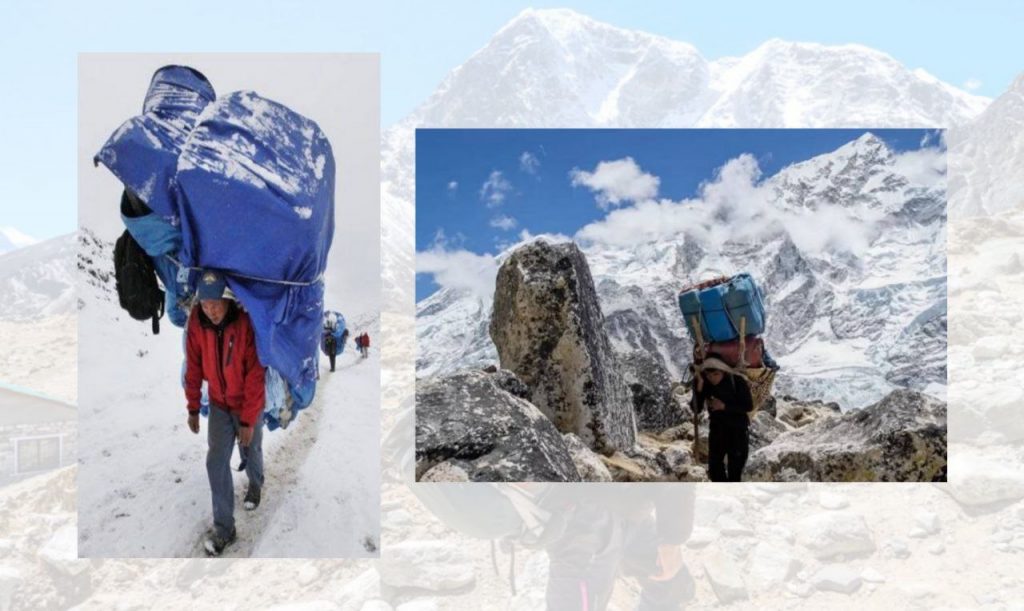
The Sherpas are a population of about 150,000 people from Nepal living in the mountains. They mostly reside in eastern Nepal but can also be found in India. They first entered Nepal around 500 years ago and settled in the Solu-Khumbu region, around the Himalayas, at altitudes ranging from 8,000 to 14,000 feet. They share close linguistic, cultural, and religious ties with Tibetans. The main occupations of Sherpas are farming, animal husbandry, trade, and porterage. They are famous for their mountaineering skills, particularly on Mount Everest, and many of them now make a living through porterage and guiding mountain climbers.
The name “Sherpa” means “people from the east,” referring to their origin in Kham, eastern Tibet. However, today this term generally refers to porters or mountain guides for tourists and climbers coming to these regions.
Many Sherpas earn their livelihood by guiding climbers to the summit of Everest and other major peaks and providing accommodation and food for climbers. At the bottom of this lucrative industry pyramid are often porters who earn only a few cents a day for carrying 20 kilograms of goods such as kerosene, food, or building materials in rain, snow, bone-chilling cold, unbearable heat, and along difficult and dangerous mountainous paths. Most of these porters are from Sherpa communities with low socio-economic status or belong to other ethnic minorities such as Rai or Magar.
In the early 20th century, Swedish and British explorers began exploring and ascending the mountains of the region, employing local Sherpas as guides and porters in exchange for payment. This brought about significant changes in Sherpa culture and customs. Mountains that were once considered sacred places for Sherpas and climbing was seen as a traditional skill, have now been transformed into lucrative resources for profit-seeking mountaineering and tourism companies targeting young and adventurous climbers and tourists. Companies exploit Sherpas and inexperienced porters, many of whom lack sufficient skills, training, and experience, as guides, cooks, or carriers for mountain climbers.
On May 14, 2015, a group of Ukrainian climbers went to Mount Everest as part of a publicity stunt for a social media startup based in Ireland, with the help of a team of Sherpas. However, during the descent, LamBabu Sherpa, a 45-year-old Sherpa working for Seven Summits Treks, a budget guiding company in Nepal, went missing. One witness to the event said, “We could tell they were inexperienced, and it wasn’t clear if they had been to Everest before. They could barely understand English and were Sherpa porters who, despite carrying extra oxygen bottles along the way, often lagged behind the other three climbers.”
Statistics show that the mortality rate of Sherpa climbers and porters on Mount Everest is 1.33 times higher than that of other foreign climbers. Since 1922, when the first attempt to ascend Everest was made, 193 climbers and 125 Sherpas lost their lives on both sides of the mountain. However, the number of casualties and injuries is believed to be much higher than reported.
On April 18, 2014, an avalanche claimed the lives of 16 Sherpas. This incident, considered one of the worst mountain disasters, deeply shocked the Sherpa community. Another avalanche at the Everest Base Camp due to a massive earthquake that shook Nepal in 2015 claimed the lives of 11 Sherpas, bringing the total to 19 casualties. The severe weather conditions and treacherous routes are not the only enemies of Sherpas. Sherpas are often exploited by companies they work for and are also exploited by the Nepali government. Many Sherpas and porters, despite not receiving the permits that foreign climbers obtain for summiting and despite the Nepali government’s awareness of this issue, are engaged in this work.
Some Sherpas spend 16 hours a day at the Khumbu Icefall installing ropes and ladders for climbers. “Gyaljen,” a 26-year-old Sherpa, says, “I don’t like this job. I do it for my family because I don’t have an education. If we don’t have an education, we can’t find a good job.”
Therefore, contrary to the common belief that Sherpas are only brave and skilled heroes and agile climbers, at the bottom layer of this, Sherpas and porters are engaged in one of the most dangerous occupations in the world due to the lack of suitable job opportunities. Individuals who, under the heavy shadow of the mighty Himalayan peaks, are exploited by profit-seeking companies and Nepali government entities and face deadly and irreparable risks.

